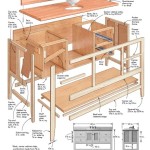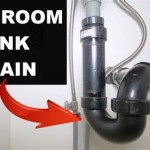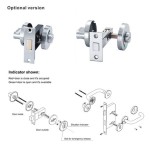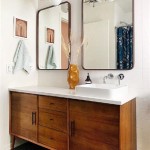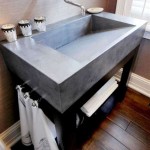Types of Bathroom Sink Mixer Taps
Bathroom sink mixer taps play a crucial role in creating a functional and aesthetically pleasing bathroom environment. These taps, also known as faucets, are responsible for controlling both hot and cold water flow, allowing users to achieve their desired water temperature. With a wide array of styles, finishes, and features available, choosing the right bathroom sink mixer tap can be a daunting task. This article provides a comprehensive overview of the various types of bathroom sink mixer taps, highlighting their unique characteristics, advantages, and disadvantages.
1. Lever Mixer Taps
Lever mixer taps, also known as single-lever mixer taps, are the most common type found in modern bathrooms. These taps feature a single lever that controls both hot and cold water flow. Moving the lever up and down adjusts the water temperature, while moving it left and right controls the water flow. Lever mixer taps are praised for their ease of use, providing one-handed operation for effortless temperature and flow control.
One of the primary advantages of lever mixer taps is their ergonomic design. The single lever allows for intuitive and effortless control, making them a popular choice for individuals with limited mobility or hand strength. Additionally, lever mixer taps are generally less prone to leaks than traditional two-handle taps, as they have fewer moving parts.
However, there are some potential drawbacks to consider. Lever mixer taps can sometimes be prone to accidental temperature changes, as a slight movement of the lever can significantly alter the water temperature. Additionally, it's important to ensure the lever is of good quality, as a faulty lever can lead to issues with water flow control.
2. Crosshead Mixer Taps
Crosshead mixer taps, also known as two-handle mixer taps, feature two separate handles for controlling hot and cold water flow. Each handle is responsible for controlling a specific water source, allowing for precise temperature adjustment. Crosshead mixer taps have been a staple in bathrooms for decades, known for their traditional aesthetic and familiar operation.
One of the major advantages of crosshead mixer taps is their ability to provide extremely precise temperature control. Users can adjust the hot and cold water flow independently, ensuring they achieve the desired temperature with accuracy. Additionally, the separate handles offer a more tactile and controlled experience, appealing to those who prefer a more traditional approach to water control.
However, crosshead mixer taps can be more challenging to operate than their lever counterparts. They require two hands to adjust the water temperature and flow, which can be inconvenient for some users. Furthermore, the multiple moving parts in crosshead mixer taps can lead to increased maintenance requirements, particularly with older models.
3. Sensor Mixer Taps
Sensor mixer taps, also known as touchless mixer taps, offer a touch-free and hygienic approach to water control. These taps feature a motion sensor that detects the presence of hands or objects, automatically activating the water flow. Sensor mixer taps are particularly well-suited for public restrooms, kitchens, and other areas where hygiene is paramount.
The primary advantage of sensor mixer taps is their contactless operation. They eliminate the need for physical contact with the tap, minimizing the spread of germs and making them ideal for public spaces. Additionally, sensor mixer taps automatically shut off the water flow after a set period, conserving water and reducing accidental water waste.
However, sensor mixer taps can be more expensive to install and maintain than traditional taps. The sensor mechanism requires reliable power supply, and any malfunction can lead to operational issues. Additionally, the lack of tactile feedback can seem less intuitive to some users, particularly those accustomed to traditional tap operation.
4. Waterfall Mixer Taps
Waterfall mixer taps are known for their unique and elegant water flow, cascading down like a gentle waterfall. These taps often feature a wide, flat spout that allows the water to flow smoothly and naturally. Waterfall mixer taps are a stylish statement piece, adding a touch of luxury and sophistication to any bathroom.
The primary advantage of waterfall mixer taps is their visually appealing water flow. The cascading effect creates a soothing and relaxing ambiance, adding a sense of tranquility to the bathroom. Additionally, waterfall mixer taps are generally quieter than traditional mixer taps, reducing noise pollution and promoting a more peaceful environment.
However, waterfall mixer taps can be more challenging to clean due to the wide spout. Mineral deposits can easily accumulate on the spout, requiring regular cleaning to maintain its aesthetic appeal. Additionally, waterfall mixer taps often have a higher flow rate than traditional taps, potentially leading to increased water consumption.

The Diffe Types Of Basin Taps Explained Tap Warehouse

Mixer Taps What Are They Types Can You Buy Sanctuary Bathrooms

Sydney Bathroom Sink Mixer Awa Faucet French Design

The Diffe Types Of Basin Taps Explained Tap Warehouse

The Diffe Types Of Basin Taps Explained Tap Warehouse

Diffe Types Of Bathroom Taps To Give Your A New Look And Style

The Bathroom Taps Buyer S Guide Bigbathroom

Mixer Taps What Are They Types Can You Buy Sanctuary Bathrooms

The Diffe Types Of Basin Taps Explained Tap Warehouse

The Diffe Types Of Basin Taps Explained Tap Warehouse
